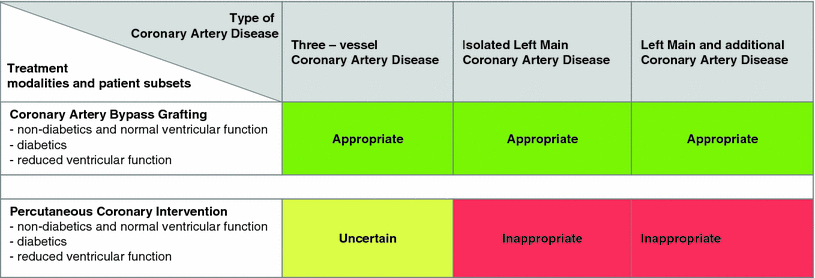In determining a treatment strategy for a patient with CAD, there are a variety of considerations that need to be made when selecting the appropriate treatment:
- Clinical outcomes differ significantly according to the treatment choice, as has been demonstrated by currently available data from the COURAGE, FREEDOM and SYNTAX trials, and emphasize that CABG is superior in the long-term treatment of revascularization in some patients with two-vessel diseases and most patients with three-vessels or Left Main CAD.
- For long–term graft patency the use of the Left Internal Mammary Artery bypass to LAD has long proven to be vastly superior to any other intervention. In the few hospitals where Off-Pump minimally invasive CABG (MIDCAB), using LIMA to LAD[1] has been compared with LAD-PCI[2], target vessel-related recurrence of angina was significantly higher in the DES group than in the MIDCAB group.
- In addition, economic analysis from the ACRE study[3] has shown that after one year CABG is more cost-effective than PCI, based on the costs of CABG or PCI (including hospital stay), drugs, admissions for chest pain, general practitioner visits, outpatient appointments, and visits to the emergency room.
- In comparison with CABG, the high costs of PCI, recurrence of angina, absence of a mortality benefit and thus absence of a marked gain in quality of life and especially, the ongoing need for repeat procedures, have all been reported in these other trials.
- New Data from the PCI Fractional Flow Reserve FAME 1 and 2 trials have shown that among patients with ischemic stenoses (FFR <0.80), PCI was suprerior to the best available medical therapy alone, but not in non-ischemic lesions (FFR>0.80).
- PCI interventions have increased rapidly during the past 10-15 years, without consideration of the medical/economic consequences, or the 2012 AHA Standard of Care Recommendations that include CABG for patients with 3V CAD and L main disease, especially in diabetics and those with reduced cardiac function:

“CABG remains the standard of care for patients with three-vessel or left main coronary artery disease”[4]
- In contrast, and despite all the evidence to the contrary, CABG surgery volumes have decreased from 30-50% during the same period, indicating
Objective Optimal Therapy data are not necessarily enough to assure Best Medical Practice
[1] Because of low case volumes MIDCAB is not necessarily comparable with traditional CABG with LIMA to LAD outcomes.
[2] Five-year follow-up of drug-eluting stents implantation vs. minimally invasive direct coronary artery bypass for left anterior descending artery disease: a propensity score analysis, Pierre Yves Etienne et al, European Journal of Cardio-Thoracic Surgery (2013) 1–7 doi:10.1093/ejcts/ezt137
[3] Cost effectiveness of clinically appropriate decisions on alternative treatments for angina pectoris: prospective observational study, S C Griffin et al.; BMJ, doi:10.1136/bmj.39129.442164.55

Comments 1
Pingback: Considerations in the Treatment of Coronary Artery Disease - Cardiac Health